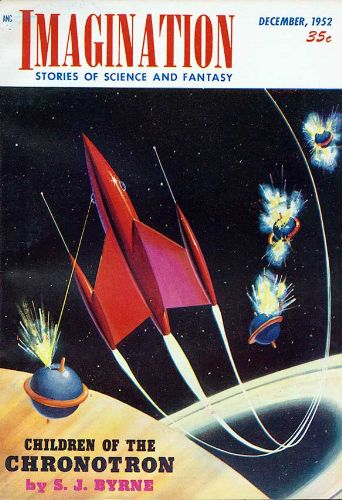|
They Were 11
is a Japanese science fiction manga series written and illustrated by Moto Hagio. It was serialized in three issues of Shogakukan's ''Bessatsu Shōjo Comic'' magazine in 1975. The following year, it won the 21st Shogakukan Manga Award in the combined and category. The series has inspired a live-action television film, an anime film, multiple stage plays, and an audio drama CD. It also inspired a sequel manga series, , serialized in ''Bessatsu Shōjo Comic'' magazine from 1976 to 1977. ''They Were Eleven'' was originally licensed in English by Viz Media in floppy comics format in 1995, and published in the manga anthology ''Four Shōjo Stories'' in 1996. The series and its sequel have been licensed by Denpa for a new English-language release in 2022. The anime film was originally licensed in English by Central Park Media, but it was discontinued in 2004. Story Ten young space cadets are put onto a decommissioned spaceship as their final test. If they pass this test, th ... [...More Info...] [...Related Items...] OR: [Wikipedia] [Google] [Baidu] |
Science Fiction Genre
Science fiction (often shortened to sci-fi or abbreviated SF) is a genre of speculative fiction that deals with imaginative and futuristic concepts. These concepts may include information technology and robotics, biological manipulations, space exploration, time travel, parallel universes, and extraterrestrial life. The genre often explores human responses to the consequences of projected or imagined scientific advances. Science fiction is related to fantasy (together abbreviated SF&F), horror, and superhero fiction, and it contains many subgenres. The genre's precise definition has long been disputed among authors, critics, scholars, and readers. Major subgenres include ''hard'' science fiction, which emphasizes scientific accuracy, and ''soft'' science fiction, which focuses on social sciences. Other notable subgenres are cyberpunk, which explores the interface between technology and society, and climate fiction, which addresses environmental issues. Precedents for sc ... [...More Info...] [...Related Items...] OR: [Wikipedia] [Google] [Baidu] |
Live-action
Live action is a form of cinematography or videography that uses photography instead of animation. Some works combine live action with animation to create a live-action animated feature film. Live action is used to define film, video games or similar visual media. Photorealistic animation, particularly modern computer animation, is sometimes erroneously described as "live action", as in the case of some media reports about Disney's remake of the traditionally animated '' The Lion King'' from 1994. According to the Cambridge English Dictionary, live action involves "real people or animals, not models, or images that are drawn, or produced by computer". Overview As the normal process of making visual media involves live action, the term itself is usually superfluous. However, it makes an important distinction in situations in which one might normally expect animation, such as when the work is adapted from a video game, or from an animated cartoon. The phrase "live action" ... [...More Info...] [...Related Items...] OR: [Wikipedia] [Google] [Baidu] |
Anime News Network
Anime News Network (ANN) is a news website that reports on the status of anime, manga, video games, Japanese popular music and other related cultures within North America, Australia, Southeast Asia and Japan. The website offers reviews and other editorial content, forums where readers can discuss current issues and events, and an encyclopedia that contains many anime and manga with information on the staff, cast, theme music, plot summaries, and user ratings. The website was founded in July 1998 by Justin Sevakis, and operated the magazine '' Protoculture Addicts'' from 2005 to 2008. Based in the United States, it has separate versions of its news content aimed toward audiences in five separate regions: the United States and Canada, the United Kingdom and Ireland, Australia and New Zealand, Southeast Asia, and India. History The website was founded by Justin Sevakis in July 1998. In May 2000, CEO Christopher Macdonald joined the website editorial staff, replacing editor-in ... [...More Info...] [...Related Items...] OR: [Wikipedia] [Google] [Baidu] |
Out-of-print
An out-of-print (OOP) or out-of-commerce item or work is something that is no longer being published. The term applies to all types of printed matter, visual media, sound recordings, and video recordings. An out-of-print book is a book that is no longer being published. The term can apply to specific editions of more popular works, which may then go in and out of print repeatedly, or to the sole printed edition of a work, which is not picked up again by any future publishers for reprint. Description Most works that have ever been published are out of print at any given time, while certain highly popular books, such as the Bible, are always "in print". Less popular out-of-print books are often rare and may be difficult to acquire unless scanned or electronic copies of the books are available. With the advent of book scanning, and print-on-demand technology, fewer and fewer works are now considered truly out of print. Contracts A publisher creates a print run of a fixe ... [...More Info...] [...Related Items...] OR: [Wikipedia] [Google] [Baidu] |
National Diet Library
The is the national library of Japan and among the largest libraries in the world. It was established in 1948 for the purpose of assisting members of the in researching matters of public policy. The library is similar in purpose and scope to the United States Library of Congress. The National Diet Library (NDL) consists of two main facilities in Tokyo and Kyoto, and several other branch libraries throughout Japan. History The National Diet Library is the successor of three separate libraries: the library of the House of Peers, the library of the House of Representatives, both of which were established at the creation of Japan's Imperial Diet in 1890; and the Imperial Library, which had been established in 1872 under the jurisdiction of the Ministry of Education. The Diet's power in pre-war Japan was limited, and its need for information was "correspondingly small." The original Diet libraries "never developed either the collections or the services which might have made ... [...More Info...] [...Related Items...] OR: [Wikipedia] [Google] [Baidu] |
Agency For Cultural Affairs
The is a special body of the Japanese Ministry of Education, Culture, Sports, Science and Technology (MEXT). It was set up in 1968 to promote Japanese arts and culture. The agency's budget for FY 2018 rose to ¥107.7 billion. Overview The agency's Cultural Affairs Division disseminates information about the arts within Japan and internationally, and the Cultural Properties Protection Division protects the nation's cultural heritage. The Cultural Affairs Division is concerned with such areas as art and culture promotion, art copyrights, and improvements in the national language. It also supports both national and local arts and cultural festivals, and it funds traveling cultural events in music, theater, dance, art exhibitions, and film-making. Special prizes are offered to encourage young artists and established practitioners, and some grants are given each year to enable them to train abroad. The agency funds national museums of modern art in Kyoto and Tokyo and The National ... [...More Info...] [...Related Items...] OR: [Wikipedia] [Google] [Baidu] |
One-shot (comics)
In comics, a one-shot is a work composed of a single standalone issue or chapter, contrasting a Limited series (comics), limited series or ongoing series, which are composed of multiple issues or chapters.Albert, Aaron"One Shot Definition" About Entertainment. Retrieved July 8, 2016. One-shots date back to the early 19th century, published in newspapers, and today may be in the form of single published Comic book, comic books, parts of Comic magazine, comic magazines/Anthology, anthologies or published online in websites. In the marketing industry, some one-shots are used as promotion tools that tie in with existing productions, films, video games or television shows. Overview In the Japanese manga industry, one-shots are called , a term which implies that the comic is presented in its entirety without any continuation. One-shot manga are often written for contests, and sometimes later developed into a full-length series, much like a television pilot. Many popular manga series bega ... [...More Info...] [...Related Items...] OR: [Wikipedia] [Google] [Baidu] |
Yahoo! Japan
is a Japanese web portal. It was the most-visited website in Japan, nearing monopolistic status. According to ''The Japan Times'', as of 2012, Yahoo! Japan had a footprint on the internet market in Japan. In terms of use as a search engine, however, it has never surpassed Google. The company is the second largest search engine used in Japan as of July 2021, with a market share of 19% behind Google's 77%. The Yahoo! Japan search engine was a directory-type search engine, similar to Yahoo! in the United States. A crawler-type search engine was used as well, and as the popularity of the crawler-type search engine gradually increased, after October 3, 2005, Yahoo! Japan began utilizing only the crawler-type engine. On June 29, 2017, Yahoo! Japan announced that the directory-based search engine "Yahoo! Category", which had been in operation since its establishment, would be abolished on March 29, 2018. As a crawler-type search engine, Yahoo! Japan initially used technology from t ... [...More Info...] [...Related Items...] OR: [Wikipedia] [Google] [Baidu] |
Daijisen
The is a general-purpose Japanese dictionary published by Shogakukan in 1995 and 1998. It was designed as an "all-in-one" dictionary for native speakers of Japanese, especially high school and university students. History Shogakukan intended for the to directly compete with Iwanami's popular desktop dictionary, which was a bestseller through three editions (1955, 1969 and 1983). The followed upon the success of two other competitors, Sanseido's ("Great forest of words", 1988, 1995, 2006) and Kōdansha's color-illustrated ("Great dictionary of Japanese", 1989, 1995). All of these dictionaries weigh around and have about 3000 pages. The 1st edition of the (1995) included over 220,000 entries and 6000 all-color illustrations and photographs. The chief editor was also chief editor of the directly competing dictionary. Other editors included , , and . Shogakukan also released a CD-ROM version (1997) of the 1st edition. The "enlarged and revised" edition (1998) was more o ... [...More Info...] [...Related Items...] OR: [Wikipedia] [Google] [Baidu] |
Four Shōjo Stories
''Four Shōjo Stories'' is a manga anthology published by Viz Media in 1996. It is a collection of manga – manga aimed at an audience of adolescent girls and young adult women – containing two works by the manga artist Keiko Nishi and one each by the manga artists Moto Hagio and Shio Satō. It was one of the earliest published works of manga released in English. The book was later pulled from publication, as Viz did not seek permission from the original publisher Shogakukan to publish the works collected in ''Four Shōjo Stories'' as an anthology. Works ;''Promise'' by Keiko Nishi The brother and father of Reiko, a teenage girl, died not long after she was born. She must cope with her mother neglecting her, including her mother's decision to remarry. Reiko begins skipping school and she often meets by chance a boy who had helped her when she was little. He helps her get used to her new situation. ;'' They Were Eleven'' by Moto Hagio Ten young space cadets are put onto a de ... [...More Info...] [...Related Items...] OR: [Wikipedia] [Google] [Baidu] |
Viz Media
Viz Media, LLC is an American entertainment company headquartered in San Francisco, California, focused on publishing manga, and distribution and licensing Japanese anime, films, and television series. The company was founded in 1986 as Viz, LLC. In 2005, Viz and ShoPro Entertainment merged to form the current Viz Media, which is owned by Japanese publishing conglomerates Shueisha and Shogakukan, as well as Japanese production company Shogakukan-Shueisha Productions (ShoPro). In 2017, Viz Media was the largest publisher of graphic novels in the United States in the bookstore market, with a 23% share of the market. History Founding Seiji Horibuchi, originally from Tokushima Prefecture in Shikoku, Japan, moved to California, United States in 1975. After living in the suburbs for almost two years, he moved to San Francisco, where he started a business exporting American cultural items to Japan, and became a writer of cultural information. He also became interested in ... [...More Info...] [...Related Items...] OR: [Wikipedia] [Google] [Baidu] |





